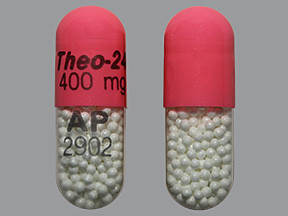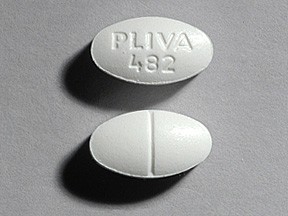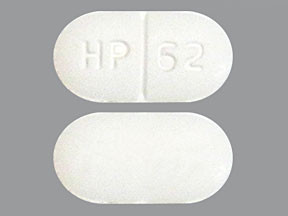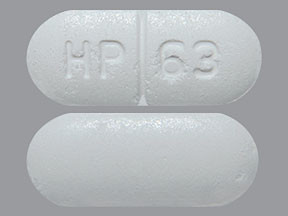THEOPHYLLINE SUSTAINED-RELEASE - ORAL
PHONETIC PRONUNCIATION: (thee-OF-i-lin)
COMMON BRAND NAME(S): Uniphyl
GENERIC NAME(S): theophylline anhydrous
Uses
USES: Theophylline is used to treat lung diseases such as asthma and COPD (bronchitis, emphysema). It must be used regularly to prevent wheezing and shortness of breath. This medication belongs to a class of drugs known as xanthines. It works in the airways by relaxing muscles, opening breathing passages, and decreasing the lungs' response to irritants. Controlling symptoms of breathing problems can decrease time lost from work or school. This medication must be used regularly to be effective. It does not work right away and should not be used to relieve sudden breathing problems. If sudden shortness of breath occurs, use your quick-relief inhaler as prescribed.
How to use THEOPHYLLINE SUSTAINED-RELEASE - ORAL
HOW TO USE: Take this medication by mouth as directed by your doctor, usually once or twice daily. Since different manufacturers have different ways to take this medication, ask your doctor or pharmacist about the best time(s) to take your brand of theophylline and if you should take the drug with or without food. Do not crush or chew the capsules or tablets. Doing so can release all of the drug at once, increasing the risk of side effects. Also, do not split the tablets unless they have a score line and your doctor or pharmacist tells you to do so. Swallow the whole or split tablet without crushing or chewing. The dosage is based on your medical condition, response to treatment, age, weight, lab tests (theophylline blood levels), and other medications you may be taking. Be sure to tell your doctor and pharmacist about all the products you use (including prescription drugs, nonprescription drugs, and herbal products). To reduce your risk of side effects, your doctor may direct you to start this medication at a low dose and gradually increase your dose. Follow your doctor's instructions carefully. Certain diets (such as high protein/low carbohydrate or high carbohydrate/low protein) may change the effect of theophylline. Tell your doctor if you have any major changes in your diet. Your doctor may need to adjust your dose. Take this medication regularly to get the most benefit from it. To help you remember, take it at the same time(s) each day. Keep taking this medication even if you feel well. Do not increase your dose, take this drug more often, or stop taking it without first consulting your doctor. Get medical help right away if your asthma symptoms worsen or if you are using your quick-relief inhaler more than usual or more often than prescribed.
Side Effects
Precautions
Interactions
Overdose
Images

- color
- pink
- shape
- oblong
- imprint
- Theo-24 400 mg, AP 2902

- color
- white
- shape
- oblong
- imprint
- PLIVA 482

- color
- white
- shape
- oblong
- imprint
- PLIVA 482
Reviews
Faq for THEOPHYLLINE SUSTAINED-RELEASE - ORAL
Theophylline sustained-release is used to treat and prevent symptoms of asthma, wheezing, shortness of breath, and chest tightness.
Theophylline sustained-release belongs to a class of medications called bronchodilators. It works by relaxing the muscles in the airways, which helps to open them up and improve breathing.
Common side effects of Theophylline sustained-release may include nausea, vomiting, stomach pain, headache, irritability, insomnia, and rapid or irregular heartbeat.
Theophylline sustained-release should be taken exactly as prescribed by your doctor. It is usually taken once or twice daily, with or without food. It is important to not crush, chew, or break the sustained-release tablet.
Yes, Theophylline sustained-release can interact with other medications, including certain antibiotics, antifungal medications, heart medications, and seizure medications. It is important to inform your doctor about all the medications you are taking to avoid any potential interactions.
If you miss a dose of Theophylline sustained-release, take it as soon as you remember. However, if it is close to your next scheduled dose, skip the missed dose and resume your regular dosing schedule. Do not double the dose to catch up.
Theophylline sustained-release should only be used during pregnancy if clearly needed and under the supervision of a healthcare provider. It is important to discuss the potential risks and benefits with your doctor.
Theophylline sustained-release can be used in children, but the dosage will depend on their weight and age. It is recommended to consult a pediatrician for proper dosage instructions.
Theophylline sustained-release usually starts working within 30 minutes to 1 hour after taking the medication. However, it may take a few days to see the full benefits.
Disclaimer
IMPORTANT: HOW TO USE THIS INFORMATION: This is a summary and does NOT have all possible information about this product. This information does not assure that this product is safe, effective, or appropriate for you. This information is not individual medical advice and does not substitute for the advice of your health care professional. Always ask your health care professional for complete information about this product and your specific health needs.


No Reviews Yet